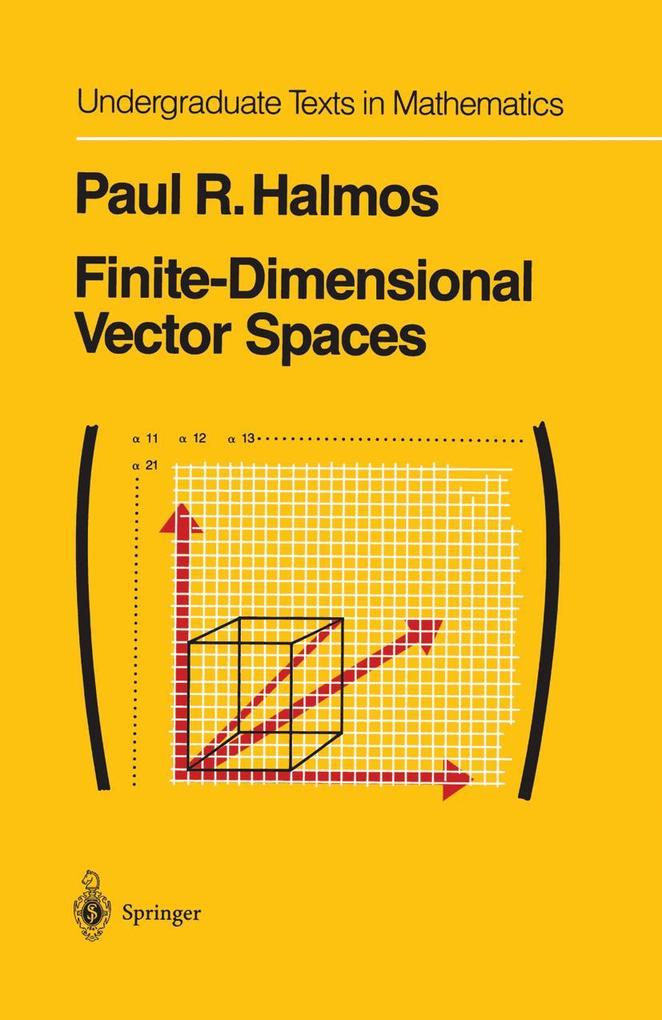The theory is systematically developed by the axiomatic method that has, since von Neumann, dominated the general approach to linear functional analysis and that achieves here a high degree of lucidity and clarity. The presentation is never awkward or dry, as it sometimes is in other modern textbooks; it is as unconventional as one has come to expect from the author. The book contains about 350 well placed and instructive problems, which cover a considerable part of the subject. All in all this is an excellent work, of equally high value for both student and teacher. Zentralblatt für Mathematik
Inhaltsverzeichnis
I. Spaces. - 1. Fields. - 2. Vector spaces. - 3. Examples. - 4. Comments. - 5. Linear dependence. - 6. Linear combinations. - 7. Bases. - 8. Dimension. - 9. Isomorphism. - 10. Subspaces. - 11. Calculus of subspaces. - 12. Dimension of a subspace. - 13. Dual spaces. - 14. Brackets. - 15. Dual bases. - 16. Reflexivity. - 17. Annihilators. - 18. Direct sums. - 19. Dimension of a direct sum. - 20. Dual of a direct sum. - 21. Quotient spaces. - 22. Dimension of a quotient space. - 23. Bilinear forms. - 24. Tensor products. - 25. Product bases. - 26. Permutations. - 27. Cycles. - 28. Parity. - 29. Multilinear forms. - 30. Alternating forms. - 31. Alternating forms of maximal degree. - II. Transformations. - 32. Linear transformations. - 33. Transformations as vectors. - 34. Products. - 35. Polynomials. - 36. Inverses. - 37. Matrices. - 38. Matrices of transformations. - 39. Invariance. - 40. Reducibility. - 41. Projections. - 42. Combinations of pro¬jections. - 43. Projections and invariance. - 44. Adjoints. - 45. Adjoints of projections. - 46. Change of basis. - 47. Similarity. - 48. Quotient transformations. - 49. Range and null-space. - 50. Rank and nullity. - 51. Transformations of rank one. - 52. Tensor products of transformations. - 53. Determinants. - 54. Proper values. - 55. Multiplicity. - 56. Triangular form. - 57. Nilpotence. - 58. Jordan form. - III. Orthogonality. - 59. Inner products. - 60. Complex inner products. - 61. Inner product spaces. - 62. Orthogonality. - 63. Completeness. - 64. Schwarz s inequality. - 65. Complete orthonormal sets. - 66. Projection theorem. - 67. Linear functionals. - 68. Parentheses versus brackets. - 69. Natural isomorphisms. - 70. Self-adjoint transformations. - 71. Polarization. - 72. Positive transformations. - 73. Isometries. - 74. Change of orthonormal basis. - 75. Perpendicular projections. - 76. Combinations of perpendicular projections. - 77. Complexification. - 78. Characterization of spectra. - 79. Spectral theorem. - 80. Normal transformations. - 81. Orthogonal transformations. - 82. Functions of transformations. - 83. Polar decomposition. - 84. Commutativity. - 85. Self-adjoint transformations of rank one. - IV. Analysis. - 86. Convergence of vectors. - 87. Norm. - 88. Expressions for the norm. - 89. Bounds of a self-adjoint transformation. - 90. Minimax principle. - 91. Convergence of linear transformations. - 92. Ergodic theorem. - 93. Power series. - Appendix. Hilbert Space. - Recommended Reading. - Index of Terms. - Index of Symbols.


































